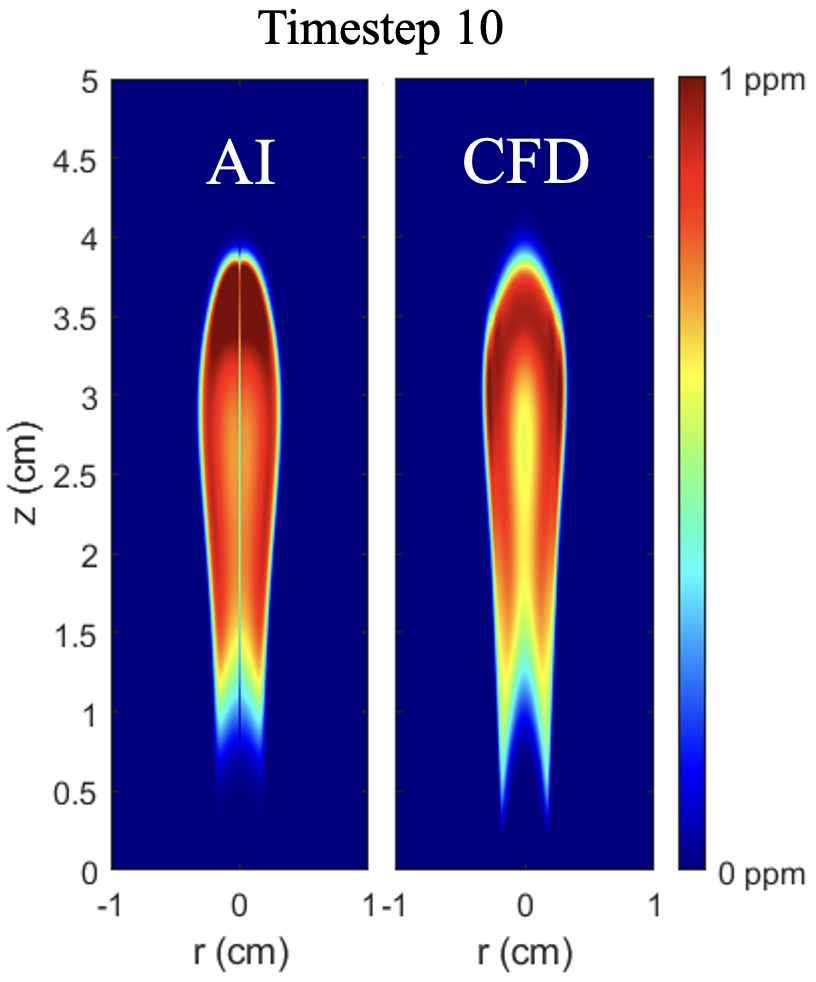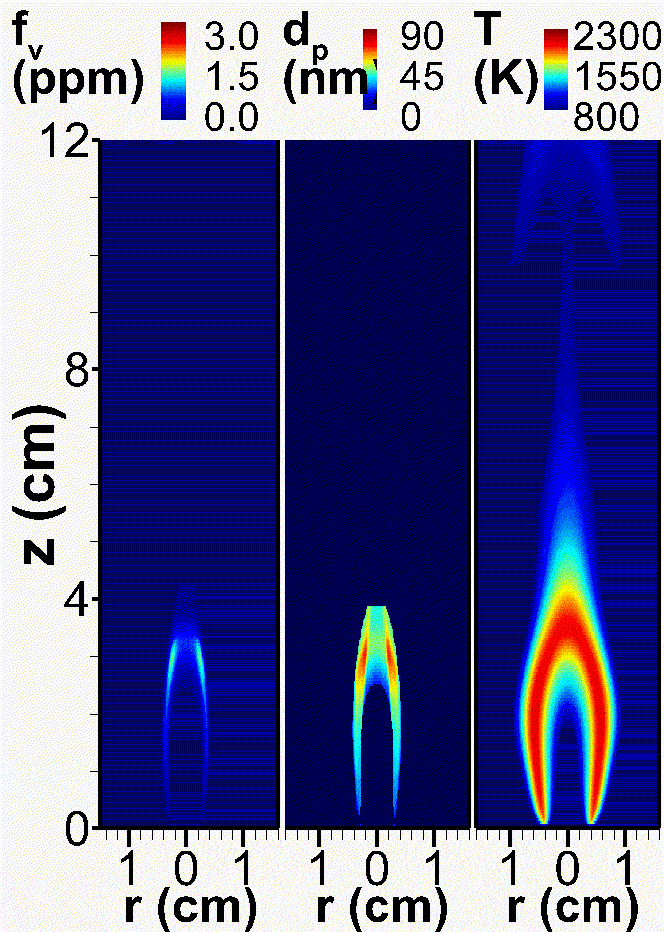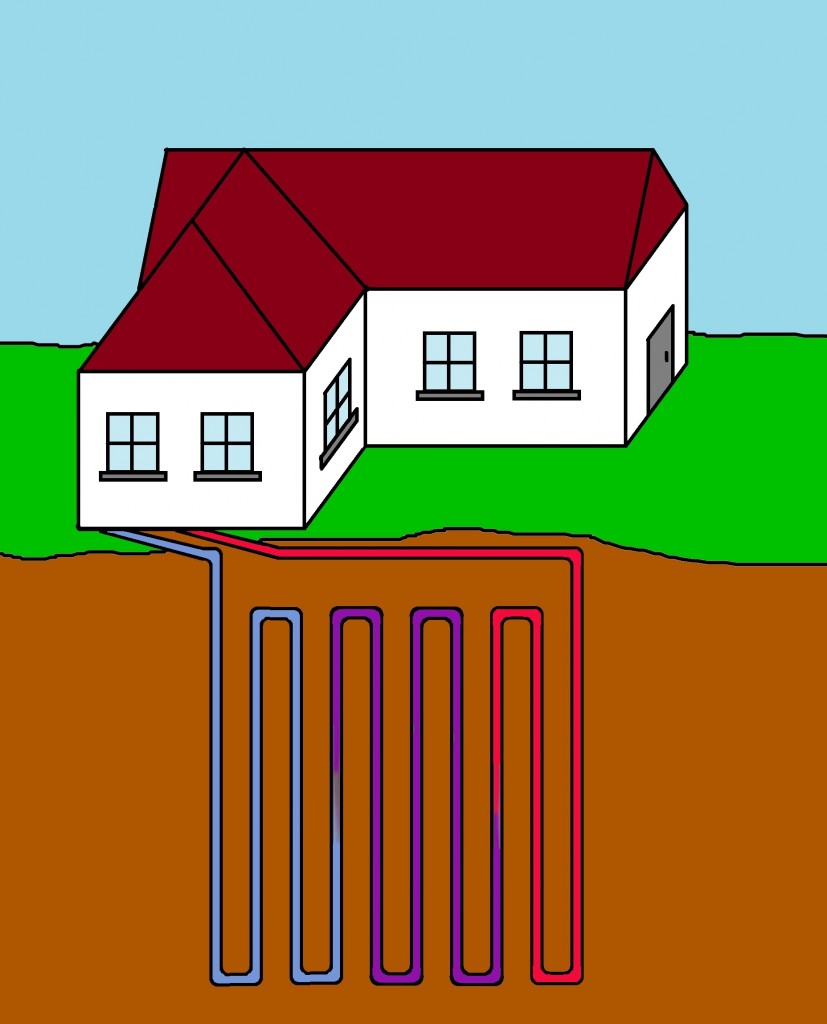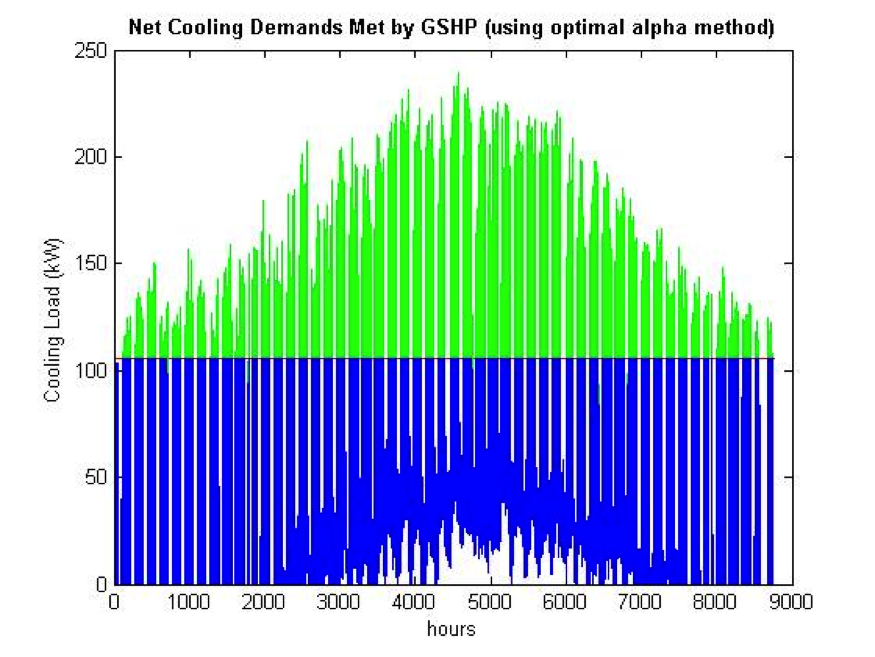Research Topics
Combustion Simulation using Computational Fluid Dynamics (fluid dynamics, chemical kinetics, particle dynamics);
- Numerical Modelling of Carbon Nanoparticle Synthesis
- Predictions of Combustion and Nanoparticle Dynamics using Artificial Intelligence
- Transient and Oscillating Flames
- Biofuels and Emissions Reduction Optimization
- High Performance Parallel Computing
Numerical Modelling and development of alternative energy systems;
- Geothermal heating and cooling
- Solar and natural gas powered heating and cooling
Consulting Areas
Combustion, Atmospheric Emissions, Soot particle formation, Geothermal heating and cooling, Alternative Energies
Research Description
COMPUTATIONAL COMBUSTION/SOOT FORMATION
AI and CFD Predicted Soot Concentration Contours in a Transient Flame

Soot Concentration, Particle Diameter, and Flame Temperature Contours in an Oscillating Flame:

My research program is motivated by a desire to simulate industrially relevant flames with realistic chemistry and transport.
Simulation of such flames can yield significant insight into the underlying physics and chemistry of combustion and provide an analytical tool for the design of combustion systems. This new capability would also facilitate a more complete assessment of efficiency and pollutant formation in practical flames – two areas of ever-increasing importance in a society concerned with energy availability and the environment.
HPCwire and The Green Car Congress among numerous other internet media sources have picked up on the results of a recent project.
Most computations are performed on SciNet, Canada’s largest supercomputing cluster. This research is cutting-edge, pushing the limits of parallel computing and its application to chemically reacting flows, and usually employs hundreds of CPUs at a time.
DESIGN OF GROUND SOURCE HEAT PUMPS
This research involves the modelling of ground-source heat pump (GSHP) systems, commonly referred to as geoexchange systems, using mathematical computational methods. Since space heating and cooling accounts for over 60% of a building’s energy demands in Canada, GSHP systems can provide a clean renewable alternative to conventional systems while meeting a building’s heating and cooling demands.

Due to high upfront costs, it is common to hybridize GSHP systems with conventional systems such as gas furnaces and air conditioners. To reduce the knowledge gap in this subject, modelling and analyses of ground loop configurations, system optimization, utility models, CO2 emissions analysis, and implementation of control strategies are some of the topics currently being investigated.
The following figures are extracted from our research demonstrating that sizing GSHP systems to meet all of the energy demand is not always most economical. The figures, for a transit facility, show that the most economical design is achieved when the GSHP system is sized to meet 44% of the transit facility’s peak cooling demands.


Peer-Reviewed Publications
- R. Daneshazarian,A.M. Bayomy, S. B. Dworkin, “NanoPCM based thermal energy storage system for a residential building” Energy Convers. Manage., 254 (2022) 115208. (Published Link)
- A. Khanehzar,F. Cepeda, S. B. Dworkin, “The influence of nitrogen and hydrogen addition/dilution on soot formation in coflow ethylene/air diffusion flames” Fuel, 309 (2022) 122244. (Published Link)
- S. Shukla,A.M. Bayomy,S. Antoun,A. Mwesigye,W.H. Leong, S. B. Dworkin, “Performance characterization of novel caisson-based thermal storage for ground source heat pumps” Renewable Energy, 174 (2021) 43-54. (Published Link)
- A.M. Bayomy,J. Wang, S. B. Dworkin, “Numerical and analytical study of a geo-exchange borehole using conventional grout and bentonite-based backfilling material” Int. J. Energy Res., 45 (2021) 13545-13562.. (Published Link)
- R. Daneshazarian,S. Antoun, S. B. Dworkin, “Performance assessment of nano-enhanced phase change material for thermal storage” Int. J. Heat Mass Transfer., 173 (2021) 121256.. (Published Link)
- S.R. Nicholson,L.R. Kober,P. Atefrad,A. Mwesigye, S. B. Dworkin, “The influence of geometry on the performance of a helical steel pile as a geo-exchange system” Renewable Energy, 172 (2021) 714-727.. (Published Link)
- M. Jadidi,L. Di Liddo, S. B. Dworkin, “A Long Short-Term Memory Neural Network for the Low-Cost Prediction of Soot Concentration in a Time-Dependent Flame” Energies, 14 (2021) 1394. (Published Link)
- M.M Mousa,A.M. Bayomy,J. Wang, S. B. Dworkin,M.Z. Saghir, “Underground energy storage utilizing concrete building foundation: Experimental and numerical approach” Int. J. Energy Res., 44 (2020) 11643-11657.. (Published Link)
- M. Jadidi,S. Kostic,L. Zimmer, S. B. Dworkin, “An artificial neural network for the low-cost prediction of soot emissions” Energies, 13 (2020) 4787. (Published Link)
- A. Mansouri,L. Zimmer, S. B. Dworkin,N.A. Eaves, “Impact of pressure-based HACA rates on soot formation in varying-pressure coflow laminar diffusion flames” Combust. Flame, 218 (2020) 109-120. (Published Link)
- A. Mwesigye,A. Kiamari, S. B. Dworkin, “Energetic optimization and exergetic performance investigation of an ejector refrigeration system using HCFO-1233zd (E) as a refrigerant” Int. J. Refrig., 112 (2020) 155-171. (Published Link)
- S. Shukla,R. Daneshazarian,A. Mwesigye,W.H. Leong, S. B. Dworkin, “A novel radiant floor system: Detailed characterization and comparison with traditional radiant systems” Int. J. Green Energy, 17 (2020) 137-148. (Published Link)
- A. Mansouri,N.A. Eaves,M.J. Thomson, S. B. Dworkin,N.A. Eaves, “Influence of pressure on near nozzle flow field and soot formation in laminar co-flow diffusion flames” Combust. Theor. Model., 23 (2019) 536-548. (Published Link)
- T. Dembeck-Kerekes,J.P. Fine,J. Friedman, S. B. Dworkin,J.J. McArthur, “Performance of variable flow rates for photovoltaic-thermal collectors and the determination of optimal flow rates” Sol. Energy., 182 (2019) 148-160. (Published Link)
- L. Zimmer,S. Kostic, S. B. Dworkin, “A novel soot concentration field estimator applied to sooting ethylene/air laminar flames” Eng. Appl. Comput. Fluid Mech., 13 (2019) 470-481. (Published Link)
- J.P. Fine, S. B. Dworkin,J. Friedman, “A methodology for predicting hybrid solar panel performance in different operating modes” Renewable Energy, 130 (2019) 1198-1206. (Published Link)
- A. Mwesigye, S. B. Dworkin, “Performance analysis and optimization of an ejector refrigeration system using alternative working fluids under critical and subcritical operation modes” Energy Convers. Manage., 176 (2018) 209-226. (Published Link)
- M. Sahafzadeh, S. B. Dworkin,L.W. Kostiuk “Predicting the consumption speed of a premixed flame subjected to unsteady stretch rates” Combust. Flame, 196 (2018) 237-248. (Published Link)
- J.P. Fine,H.V. Nguyen,J. Friedman,W.H. Leong, S. B. Dworkin “A simplified ground thermal response model for analyzing solar-assisted ground source heat pump systems” Energy Convers. Manage., 165 (2018) 276-290. (Published Link)
- R. Alexander,S. Bozorgzadeh,A. Khosousi, S. B. Dworkin “Development and testing of a soot particle concentration estimator using Lagrangian post-processing” Eng. Appl. Comput. Fluid Mech., 12 (2018) 236-249. (Published Link)
- A. Veshkini, S. B. Dworkin, “A Computational Study of Soot Formation and Flame Structure of Coflow Laminar Methane/air Diffusion Flames Under Microgravity and Normal Gravity,” Combust. Theor. Model., 21 (2017) 864-878. (Published Link, Open Access Link)
- M. Sahafzadeh, L. W. Kostiuk, S. B. Dworkin, “Transient Response of a Laminar Premixed Flame to a Radially Diverging/Converging Flow,” Combust. Flame, 179 (2017) 51-62. (Published Link, Open Access Link)
- A. A. Alaica, S. B. Dworkin, “Characterizing the Effect of an Off-Peak Ground Pre-Cool Control Strategy on Hybrid Ground Source Heat Pump Systems,” Energ. Buildings, 137 (2017) 46-59. (Published Link, Open Access Link)
- J. Fine, J. Friedman, S. B. Dworkin, “Detailed Modeling Of A Novel Photovoltaic Thermal Cascade Heat Pump Domestic Water Heating System,” Renew. Energ., 101 (2017) 500-513. (Published Link, Open Access Link)
- N. A. Eaves, S. B. Dworkin, M. J. Thomson, “Assessing Relative Contributions of PAHs to Soot Mass by Reversible Heterogeneous Nucleation and Condensation,” P. Combust. Inst., 36 (2017) 935-945. (Published Link, Open Access Link Pending)
- N. A. Eaves, S. B. Dworkin, M. J. Thomson, “CoFlame: A Refined and Validated Numerical Algorithm for Modeling Sooting Laminar Diffusion Flames,” Comput. Phys. Commun., 207 (2016) 464-477. (Published Link, Open Access Link)
- Y. L. E. Law, S. B. Dworkin, “Characterization of the Effects of Borehole Configuration and Interference with Long Term Ground Temperature Modelling of Ground Source Heat Pumps,” Appl. Energ., 179 (2016) 1032-1047. (Published Link, Open Access Link)
- A. Veshkini, S. B. Dworkin, M. J. Thomson, “Understanding Soot Particle Size Evolution in Laminar Ethylene/Air Diffusion Flames Using Novel Soot Coalescence Models,” Combust. Theor. Model., 20 (2016) 707-734. (**Cover article**) (Published Link)
- A. Veshkini, N. A. Eaves, S. B. Dworkin, M. J. Thomson, “Application of PAH-Condensation Reversibility in Modeling Soot Growth in Laminar Premixed and Nonpremixed Flames,” Combust. Flame., 167 (2016) 335-352. (Published Link)
- H. V. Nguyen, Y. L. E. Law, X. Zhou, P. R. Walsh, W. H. Leong, S. B. Dworkin, “A Techno-economic Analysis of Heat-Pump Entering Fluid Temperatures, and CO2 Emissions for Hybrid Ground-Source Heat Pump Systems,” Geothermics, 61 (2016) 24-34. (Published Link, Open Access Link)
- N. Kuzmic, Y. L. E. Law, S. B. Dworkin, “Numerical Heat Transfer Comparison Study of Hybrid and Non-hybrid Ground Source Heat Pump Systems,” Appl. Energ., 165 (2016) 919-929. (Published Link, Open Access Link)
- N. Ekrami, Z. M. Hasib, S. B. Dworkin, A. S. Fung, D. Naylor, “Residential Application of a Natural Gas Based Tri-generation System for Cold Climates,” ASHRAE-Transactions 121 (2015) 504-510.
- A. Khosousi, S. B. Dworkin, “Soot Surface Reactivity during Surface Growth and Oxidation in Laminar Diffusion Flames,” Combust. Flame, 162:12 (2015) 4523-4532.
- J. Fine, J. Friedman, S. B. Dworkin, “Transient Analysis of a Photovoltaic Thermal Heat Input Process with Thermal Storage,” Appl. Energ., 160 (2015) 308-320.
- A. Khosousi, F. Liu, S. B. Dworkin, N. A. Eaves, M. J. Thomson, X. He, Y. Dai, S. Shuai, J. Wang, “Experimental and Numerical Study of Soot Formation in Laminar Coflow Diffusion Flames of Gasoline/Ethanol Blends,” Combust. Flame 162:10 (2015) 3925-3933.
- A. Khosousi, S. B. Dworkin, “Detailed Modelling of Soot Oxidation by O2 and OH in Laminar Diffusion Flames,” P. Combust. Inst. 35 (2015) 1903-1910.
- N. A. Eaves, S. B. Dworkin, M. J. Thomson, “The Importance of Reversibility in Modeling Soot Nucleation and Condensation Processes,” P. Combust. Inst. 35 (2015) 1787-1794.
- N. Ekrami, Z. M. Hasib, P. Lele, S. B. Dworkin, A. S. Fung, D. Naylor, “Preliminary Test and Analysis of A Stirling Engine Based Residential Tri-generation system at TRCA Archetype Sustainable House,” ASHRAE-Transactions 120:2 (2014) 273-284.
- A. Veshkini, S. B. Dworkin, M. J. Thomson, “A Soot Particle Surface Reactivity Model Applied to a Wide Range of Laminar Ethylene/Air Flames,” Combust. Flame. 161:12 (2014) 3191-3200.
- H. V. Nguyen, Y. L. E. Law, M. Alavy, P. R. Walsh, W. H. Leong, S. B. Dworkin, “An Analysis of the Factors affecting Hybrid Ground-Source Heat Pump Installation Potential in North America,” Appl. Energ. 125 (2014) 28-38.
- M. Alavy, S. B. Dworkin, W. H. Leong, “A Design Methodology and Analysis of Combining Multiple Buildings onto a Single District Hybrid Ground Source Heat Pump System,” Renew. Energ., 66 (2014) 515-522.
- V. Chernov, M. J. Thomson, S. B. Dworkin, N. A. Slavinskaya, U. Riedel, “Soot Formation with C1 and C2 Fuels using an Improved Chemical Mechanism for PAH Growth,” Combust. Flame, 161 (2014) 592-601.
- N. A. Eaves, M. J. Thomson, S. B. Dworkin, “The Effect of Conjugate Heat Transfer on Soot Formation Modelling at Elevated Pressures,” Combust. Sci. Technol., 85 (2013) 1799-1819.
- M. Alavy, H. V. Nguyen, W. H. Leong, S. B. Dworkin, “A Methodology and Computerized Approach for Optimizing Hybrid Ground Source Heat Pump System Design,” Renew. Energ., 57 (2013) 404-412.
- M. Saffaripour, M. Kholghy, Q. Zhang, S. B. Dworkin, M. J. Thomson, “A Numerical and Experimental Study of Soot Formation in a Laminar Coflow Diffusion Flame of a Jet A-1 Surrogate,” P. Combust. Inst., 34 (2013) 1057-1065.
- S. A. Esfarjani, S. B. Dworkin, J. Mostaghimi, K. S. Kim, C. T. Kingston, B. Simard, G. Soucy, “Detailed Numerical Simulation of Single-Walled Carbon Nanotube Synthesis in a Radio-Frequency Induction Thermal Plasma System,” J. Phys.: Conf. Ser., 406 (2012) 012011.
- F. Liu, S. B. Dworkin, M. J. Thomson, G. J. Smallwood, “Modeling DME Addition Effects to Fuel on PAH and Soot in Laminar Coflow Ethylene/air Diffusion Flames using two PAH Mechanisms,” Combust. Sci. Technol., 184 (2012) 966-979.
- N. A. Eaves, A. Veshkini, C. Riese, Q. Zhang, S. B. Dworkin, M. J. Thomson, “A Numerical Study of High Pressure, Laminar, Sooting, Ethane-Air Coflow Diffusion Flames,” Combust. Flame, 159:10 (2012) 3179-3190.
- V. Chernov, Q. Zhang, M. J. Thomson, S. B. Dworkin, “Numerical Investigation of Soot Formation Mechanisms in Partially-premixed Ethylene–air Co-flow Flames,” Combust. Flame, 159:9 (2012) 2789-2798.
- N. A. Slavinskaya, U. Riedel, S. B. Dworkin, M. J. Thomson, “Detailed Numerical Modelling of PAH Formation and Growth in Non-Premixed Ethylene and Ethane Flames,” Combust. Flame, 159:3 (2012) 979-995.
- S. B. Dworkin, Q. Zhang, M. J. Thomson, N. A. Slavinskaya, U. Riedel, “Application of an Enhanced PAH Growth Model to Soot Formation in a Laminar Coflow Ethylene/Air Diffusion Flame,” Combust. Flame, 158:9 (2011) 1682-1695.
- M. Saffaripour, P. Zabeti, S. B. Dworkin, Q. Zhang, H. Guo, F. Liu, G. J. Smallwood, M. J. Thomson, “A Numerical and Experimental Study of a Laminar Sooting Coflow Jet-A1 Diffusion Flame,” P. Combust. Inst., 33 (2011) 601-608.
- S. B. Dworkin, J. A. Cooke, B. A. V. Bennett, M. D. Smooke, R. J. Hall, M. B. Colket, “Distributed-Memory Parallel Computation of a Forced, Time-Dependent, Sooting, Ethylene/Air Coflow Diffusion Flame,” Combust. Theor. Model., 13:5 (2009) 795-822. (**Cover article**)
- S. B. Dworkin, M. D. Smooke, V. Giovangigli, “The Impact of Detailed Multicomponent Transport and Thermal Diffusion Effects on Particulate Formation in Ethylene/Air Flames,” P. Combust. Inst., 32:1 (2009) 1165-1172.
- S. B. Dworkin, A. M. Schaffer, B. C. Connelly, M. B. Long, M. D. Smooke, M. P. Puccio, B. McAndrews, J. H. Miller, “Measurements and Calculations of Formaldehyde Concentrations in a Methane/N2/Air, Non-Premixed Flame: Implications for Heat Release Rate,” P. Combust. Inst., 32:1 (2009) 1311-1318.
- S. B. Dworkin, B. C. Connelly, A. M. Schaffer, B. A. V. Bennett, M. B. Long, M. D. Smooke, M. P. Puccio, B. McAndrews, J. H. Miller, “Computational and Experimental Study of a Forced, Time-Dependent, Methane-Air Coflow Diffusion Flame,” P. Combust. Inst., 31:1 (2007) 971-978.
- S. B. Dworkin, B. A. V. Bennett, M. D. Smooke, “A Mass-Conserving Vorticity-Velocity Formulation with Application to Nonreacting and Reacting Flows,” J. Comput. Phys., 215:2 (2006) 430-447.
- S. B. Dworkin, T. J. Nye, “Image Processing for Machine Vision Measurement of Hot Formed Parts,” J. Mater. Process. Tech., 174:1-3 (2006) 1-6.
Other Non-scientific Publications
- “Clearing the Air: How HPC is Helping Improve our Air Quality,” M. Saffaripour, S. B. Dworkin, and M. J. Thomson (written by S. B. Dworkin), SciNet Portal Quarterly Newsletter 1 (2010) p.10.
Invited Talks
- “Hybrid Geothermal Solutions: The Ryerson Method for Analyzing Geothermal Potential” McMaster Innovation Park, McMaster University, Hamilton, Canada, April 14, 2016.
- “HVAC Design using Hybrid Geothermal Systems” MCW Consultants Ltd., Toronto, Canada, March 8, 2015.
- “Addressing Atmospheric Emissions Through the Development of Novel Numerical Algorithms and High-Performance Computation” Lassonde School of Engineering, York University, Toronto, Canada, February 26, 2013.
- “Development of a Solar and Natural Gas Powered Air Conditioner: a Micro Tri-generation System” Centre for Urban Energy Hosts the Ontario Minister of Energy, Ryerson University, Toronto, Canada, March 22, 2012.
- “Recent Advances in the Modelling and Understanding of Soot Formation in Combustion: An Application of Large-Scale Computation” Mechanical and Mechatronics Engineering, University of Waterloo, Waterloo, Canada, August 19, 2011.
- “Recent Developments in Flame and Soot Modelling: An Application of Large-Scale Computation” The German Aerospace Center (DLR), Stuttgart, Germany, June 27, 2011.
- “Computational Combustion: Toward the use of Sustainable and Alternative Fuels” SciNet Computing Consortium, University of Toronto, Toronto, Canada, February 9, 2011.
- “Computational and Experimental Study of Sooting and Nonsooting Forced, Time-Dependent, Coflow Diffusion Flames,” Department of Propulsion and Thermofluid-Dynamics, Universidad Carlos III de Madrid, Madrid, Spain, September 26, 2008.